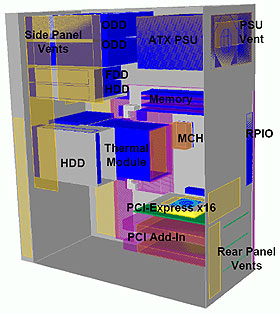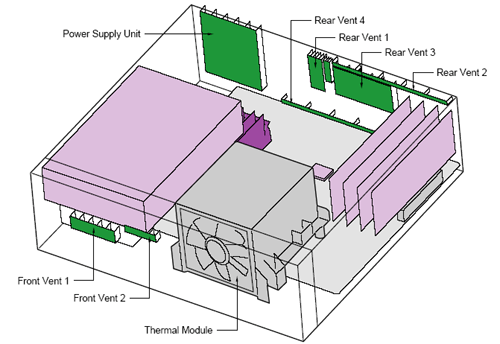The peripheral slots have also been shifted around in the
new BTX motherboards. In the ATX design, they were located at the bottom
of the case (in a tower configuration) or in 'desktop' style PCs, on the left
side of the motherboard. BTX shifts them over to the other side of the board,
where the I/O ports were in ATX motherboard designs. This move allows the VPU on
the video card to be cooled by the thermal module's stream of air as it passes
through the middle of the case.
This design should benefit video card manufacturers greatly. Previously, they
could not count on any outside airflow being passed over the fronts of
videocards, seeing as how PCI Express video cards face away from the processor and
system fans in ATX cases.
The motherboard chipsets (Northbridge and Southbridge)
have also had their locations formalized in the middle of the motherboard,
in-line with the thermal module's stream of air. They are next
in line after the processor to receive fresh air from the front
vent, with the idea that the can be passively cooled with the CPU heatsink
exhaust air stream.
System memory has been placed where the PCI Express/AGP slot would reside
in ATX designs; slightly below (left of) the center of the board and the
air stream provided by the thermal module. To aid in air circulation,
the memory slots travel in the same direction as the airflow (front to
back). Though they are slightly out of the main flow of air, the memory modules
should receive cooling since the power supply will pull some air across them with its
exhaust fan. RAM cooling is not a major factor in current systems, so no
real focus has been given to it in BTX.

Interestingly, the BTX form-factor also provides for airflow under the motherboard. Part of the air pulled
in by the thermal module will be directed on the same line underneath
the board, cooling as it goes. This can potentially help in the thermal
regulation of several essential system components, not the least of which being
the CPU socket, MOSFET's, and BGA chipsets. To enable this, the motherboard will
obviously sit further away from the floor or wall of the case than it has in the
past.
 BTX Case Changes
BTX Case Changes
Several changes to computer
case layouts have also had to be made to accommodate the new
BTX motherboard form-factor. I/O and expansion ports are now in different locations
on the back of the case, and each BTX case must have a 'thermal module interface'
at the front.
The thermal module interface is the vent that provides
outside air directly to the thermal module, and must be engineered so that the
vent and the thermal module fit precisely. This is to prevent air
from inside the case being recycled. An equivalent exhaust vent must also
be present at the rear of the case, both above and below the motherboard plane according
to Intel documents.
A few companies have already released one or two
different BTX tower cases, but demand for these full-size cases is
likely to be slow for most of 2005. The BTX case appears identical to a
standard ATX case, except that the motherboard tray is on the left wall of the case,
rather than the right as ATX cases do. This enables the peripheral and I/O
ports to be more or less in the position that most people are familiar with
despite its relocation on the actual BTX motherboards.
Acoustical Considerations
Intel appears to have gone to a lot of trouble to ensure that the thermal module will not recycle heated air from
inside the case when cooling the CPU. The front thermal module
interface links to the thermal module via a gasket, and its stream of air is
vented out the rear of the case only, ensuring a steady flow of new air.
On paper, it's hard to see how this could fail to cool modern processors and
chipsets well, as compared to the current, rather haphazard ATX design.
The proof will be in the testing though.

A single 90mm fan should be good news for folks who like quiet systems. The fan will vary between 900 and
4500 RPM depending on system temperature (as judged by the CPU temperature as well
as a sensor placed on the motherboard right in the primary air flow). Looks
like Intel's version of AMD's 'cool n' quiet' tech is finally here. It'll
be interesting to see how much noise a BTX system really generates excluding the
video card fan when they finally reach the PCstats labs.
